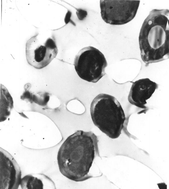In vitro effect of 5-aminolaevulinic acid plus visible light on Candida albicans
Abstract
Photodynamic therapy, currently used as an alternative technique for the treatment of superficial non-melanoma skin cancers, has been employed in vitro to kill different species of microorganisms. Here the development of Candida albicans colonies has been measured after application of 5-aminolaevulinic acid (ALA) plus visible light (VIS) irradiation. C. albicans suspensions (10 colony forming units µl−1) have been prepared. For the experiment 30 µl of suspension have been incubated in the dark for 3 h, with increasing concentrations of ALA (125, 250, 300, 350, 400, 450, 500, 550, 600, 750, 1000 mg ml−1) and then irradiated with a fixed dose (40 J cm−2) of VIS. Immediately after the irradiative session, the C. albicans suspensions were disseminated on dishes containing a Sabouraud agar + CAF medium and cultured in the dark at 27 °C; after 48 h colony development has been measured. In the same way four controls have been prepared: (i)
C. albicans suspensions not treated with ALA-PDT; (ii)
C. albicans suspensions incubated with increasing ALA concentrations without VIS; (iii)
C. albicans suspensions irradiated with 40 J cm−2 of VIS without ALA; (iv)
C. albicans suspensions irradiated immediately after the addition of increasing concentrations of ALA without the 3 h incubation. Colonies treated with ALA-PDT have been studied with

- This article is part of the themed collection: Photosensitized inactivation of microorganisms

 Please wait while we load your content...
Please wait while we load your content...